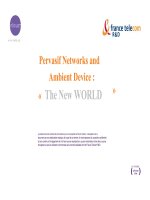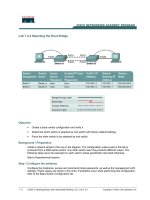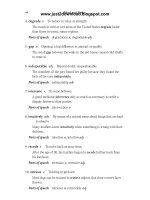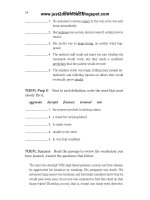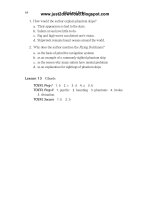Tài liệu ESP TARGET SITUATION NEEDS ANALYSIS: THE ENGLISH LANGUAGE COMMUNICATIVE NEEDS AS PERCEIVED BY HEALTH PROFESSIONALS IN THE RIYADH AREA docx
Bạn đang xem bản rút gọn của tài liệu. Xem và tải ngay bản đầy đủ của tài liệu tại đây (875.65 KB, 193 trang )
ESP TARGET SITUATION NEEDS ANALYSIS: THE ENGLISH LANGUAGE
COMMUNICATIVE NEEDS AS PERCEIVED BY HEALTH PROFESSIONALS IN THE
RIYADH AREA
by
MAJID ALHARBY
(Under the Direction of Linda Harklau)
ABSTRACT
Although the ESP approach is widely used in English language programs in Saudi
Arabia, few applications have been conducted to customize ESP courses to suit the Saudi work
environment. The medical field represents this challenge since English is used as the tool of
communication in the Saudi medical field.
The purpose of this study was to investigate the English language communicative needs
of health professionals in the Riyadh area by investigating their language use in the workplace in
order to provide empirical data serving Saudi ESP context.
The study used the framework of needs analysis to investigate the extent of English use
in the careers of medical professionals, the required level of the reading, writing, listening and
speaking skills in different activities, and the perception of health professionals towards their
English language preparation during their previous college study.
A questionnaire was constructed and distributed to three different hospitals in the Riyadh
area representing five different medical sites. The sample population consisted of health
professionals representing physicians, dentists, pharmacists, and applied medical technicians.
787 questionnaires were distributed. Out of these 787 questionnaires, 259 came back
representing a response rate of 32.9%. Out of the 259 received questionnaires, 34 were
disregarded due to incomplete answers or non qualified respondents. This brought the total
number of usable forms to 225 questionnaires. The questionnaire consisted of 22 items and 20
sub-items. For each item and sub-item, frequency and percentage were calculated using the SPSS
statistical package.
The findings of the study indicated that the English language is used extensively at the
workplace and plays an important role in the careers of health professionals. However,
physicians and dentists used English more often than pharmacists and applied medical
specialists. The findings also indicated that the receptive skills (e.g. reading and listening) were
perceived as more important than the productive skills (speaking and writing). However, the
differences in percentages between receptive skills and productive skills were too close to make
an affirmative judgment. Finally, the findings revealed that the English language courses that
health professionals took at the college level were inadequate in relating the English language
use to their medical needs.
INDEX WORDS: Linguistics, Second Language Acquisition, Applied Linguistics, TESOL,
English for Specific Purposes, Language Use, Communicative
Competence, Needs Analysis, Needs Assessment, Target Needs Analysis.
ESP TARGET SITUATION NEEDS ANALYSIS: THE ENGLISH LANGUAGE
COMMUNICATIVE NEEDS AS PERCEIVED BY HEALTH PROFESSIONALS IN THE
RIYADH AREA
by
MAJID ALHARBY
B.A., Umm Al-Qura University, Saudi Arabia, 1992
M.A., West Virginia University, Morgantown, West Virginia, 1997
A Dissertation Submitted to the Graduate Faculty of The University of Georgia in Partial
Fulfillment of the Requirements for the Degree
DOCTOR OF PHILOSOPHY
ATHENS, GEORGIA
2005
© 2005
Majid Alharby
All Rights Reserved
ESP TARGET SITUATION NEEDS ANALYSIS: THE ENGLISH LANGUAGE
COMMUNICATIVE NEEDS AS PERCEIVED BY HEALTH PROFESSIONALS IN THE
RIYADH AREA
by
MAJID ALHARBY
Major Professor: Linda Harklau
Committee: Betsy Rymes
Melisa Cahnmann
Joseph Wisenbaker
Electronic Version Approved:
Maureen Grasso
Dean of the Graduate School
The University of Georgia
May, 2005
iv
DEDICATION
to my parents
for their unconditional love and support
v
ACKNOWLEDGEMENTS
First and foremost, I would like to thank Allah for his help and guidance throughout my
life. My gratitude is extended to my parents for their continuous prayers, encouragement, and
patience. My thanks also go to my sisters for their encouragement and support. I am especially
grateful to my brother Samir who not only helped me in conducting the pilot study of this
dissertation but also acted on my behalf socially and financially in different tasks in Saudi Arabia
while I was pursuing my graduate studies in the United States.
My deepest love and appreciation go to my dear wife who not only helped me in
preparing materials and statistics for this study, but also carried most of the burden in raising our
children. I am also grateful for my children who provided me with a continuous source of
inspiration and joy.
I would also like to express my greatest gratitude to my major professor and the head of
my dissertation committee Dr. Linda Harklau who provided me with support and encouragement
throughout my study at the University of Georgia. Her academic advice and meticulous revisions
provided me with guidance during all phases of this dissertation. I would also like to thank the
other members of my dissertation committee; Dr. Betsy
Rymes, Dr. Melisa Cahnmann, and Dr.
Joseph Wisenbaker for serving in my committee and sharing their expertise with me.
Sincere gratitude goes to my colleague and friend Khalid Alshaya who distributed and collected
the questionnaires in Riyadh along with preparing the necessary paper work to do so. I am in debt to him
for his kindness and assistance.
Finally, I would like to thank my beloved country Saudi Arabia for the scholarship that enabled
me to continue my graduate studies in the United States.
vi
TABLE OF CONTENTS
Page
ACKNOWLEDGEMENTS v
LIST OF TABLES viii
LIST OF CHARTS xiii
CHAPTER
ONE INTRODUCTION 1
Statement of the Problem 2
Research Questions 5
Significance of the Study 6
TWO LITERATURE REVIEW 7
Overview 7
Theoretical Background 10
Definitions of Needs Analysis 15
Needs Analysis Models 17
Research Studies in Needs Analysis 20
THREE METHODOLOGY 28
Overview 28
Setting and Participants 30
Developing the Questionnaire 35
Piloting and Validation 40
Data Collection 44
vii
FOUR RESULTS AND ANALYSIS 46
Introduction 46
Results of the First Research Question 50
Results of the Second Research Question 60
Results of the Third Research Question 112
FIVE DISCUSSION AND RECOMMENDATIONS 125
Discussion and Conclusions 125
Recommendations and Directions for Further Research 153
REFERENCES 156
APPENDICES 161
A Questionnaire (English Version) 162
B Questionnaire (Arabic Version) 168
C Data Collection Sites 174
viii
LIST OF TABLES
Page
Table 3.1 Graduates from the Medical Colleges at KSU in 2000-2001……………… …33
Table 3.2 Study Site (Saudi Employees)………………………………………………… 34
Table 3.3 Chart of Research Questions, Sub-questions,
and Questionnaire Items… …………………………………………………… 39
Table 3.4 Evaluation Chart for the Pretesting Phase
of the Questionnaire…………………………………………………………… 43
Table 4.1 First Research Question and its Sub-questions….……………………………….53
Table 4.2 Distribution of Frequencies and Percentages of
the Perceived Percentage of Using English in the Workplace………………… 54
Table 4.3 Distribution of Frequencies and Percentages
of Medical Training in the Workplace………………………………………… 55
Table 4.4 Distribution of Frequencies and Percentages
of Languages Used in Medical Training in the Workplace…………………… 56
Table 4.5 Distribution of Frequencies and Percentages
of Having People in the Workplace who
Communicate in English only ……………………………………… …………57
Table 4.6 Distribution of Frequencies and Percentages
of Communicating with People in the
Workplace who Communicate in English only……………………….…………58
Table 4.7 Distribution of Frequencies and Percentages
of the Importance of Having a High Level of
English Proficiency to Perform the Job Effectively…………………………… 59
Table 4.8 Second Research Question and its Sub-questions……………………………….73
Table 4.9 Distribution of Frequencies and Percentages of the Required
Level of Proficiency in Listening Skills to Perform the
Job Effectively as Perceived by All Respondents……………………………… 74
Table 4.10 Distribution of Frequencies and Percentages of the
Required Level of Proficiency in Listening Skills to
Perform the Job Effectively as Perceived by Physicians……………………… 75
ix
Table 4.11 Distribution of Frequencies and Percentages of the
Required Level of Proficiency in Listening Skills to
Perform the Job Effectively as Perceived by Dentists………………………… 76
Table 4.12 Distribution of Frequencies and Percentages of the
Required Level of Proficiency in Listening Skills to
Perform the Job Effectively as Perceived by Pharmacists…………………… 77
Table 4.13 Distribution of Frequencies and Percentages of the
Required Level of Proficiency in Listening Skills to
Perform the Job Effectively as Perceived by Applied
Medical Technicians…………………………………………………………… 78
Table 4.14 Distribution of Frequencies and Percentages
of the Required Level of Proficiency in
Speaking Skills to Perform the Job Effectively
as Perceived by All Respondents……………………… …………………… 79
Table 4.15 Distribution of Frequencies and Percentages of the
Required Level of Proficiency in Speaking Skills to
Perform the Job Effectively as Perceived by Physicians……………………… 80
Table 4.16 Distribution of Frequencies and Percentages of the
Required Level of Proficiency in Speaking Skills to
Perform the Job Effectively as Perceived by Dentists………………………… 81
Table 4.17 Distribution of Frequencies and Percentages of the
Required Level of Proficiency in Speaking Skills to
Perform the Job Effectively as Perceived by Pharmacists………………….… 82
Table 4.18 Distribution of Frequencies and Percentages of the
Required Level of Proficiency in Speaking Skills to
Perform the Job Effectively as Perceived by Applied
Medical Technicians……………………………………………………….… 83
Table 4.19 Distribution of Frequencies and Percentages
of the Required Level of Proficiency in
Reading Skills to Perform the Job Effectively
as Perceived by All Respondents………………………………… ……………84
x
Table 4.20 Distribution of Frequencies and Percentages of the
Required Level of Proficiency in Reading Skills to
Perform the Job Effectively as Perceived by Physicians……………………… 85
Table 4.21 Distribution of Frequencies and Percentages of the
Required Level of Proficiency in Reading Skills to
Perform the Job Effectively as Perceived by Dentists………………………… 86
Table 4.22 Distribution of Frequencies and Percentages of the
Required Level of Proficiency in Reading Skills to
Perform the Job Effectively as Perceived by Pharmacists………………….… 87
Table 4.23 Distribution of Frequencies and Percentages of the
Required Level of Proficiency in Reading Skills to
Perform the Job Effectively as Perceived by
Applied Medical Technicians ………………………….……………………… 88
Table 4.24 Distribution of Frequencies and Percentages
of the Required Level of Proficiency in
Writing Skills to Perform the Job Effectively
as Perceived by All Respondents………………………… ……………………89
Table 4.25 Distribution of Frequencies and Percentages of the
Required Level of Proficiency in Writing Skills to
Perform the Job Effectively as Perceived by Physicians……….……………… 90
Table 4.26 Distribution of Frequencies and Percentages of the
Required Level of Proficiency in Writing Skills to
Perform the Job Effectively as Perceived by Dentists…………………….…… 91
Table 4.27 Distribution of Frequencies and Percentages of the
Required Level of Proficiency in Writing Skills to
Perform the Job Effectively as Perceived by
Pharmacists…………………………………………………….……………… 92
Table 4.28 Distribution of Frequencies and Percentages of the
Required Level of Proficiency in Writing Skills to
Perform the Job Effectively as Perceived by
Applied Medical Technicians………………………………………….…….… 93
Table 4.29 Distribution of Frequencies and Percentages
of Ranking the Importance of the Four Language
Skills as Perceived by All Respondents………………………………….…… 94
xi
Table 4.30 Distribution of Frequencies and Percentages
of Ranking the Importance of the Four Language
Skills as Perceived by Physicians … 95
Table 4.31 Distribution of Frequencies and Percentages
of Ranking the Importance of the Four Language
Skills as Perceived by Dentists…… 96
Table 4.32 Distribution of Frequencies and Percentages
of Ranking the Importance of the Four Language
Skills as Perceived by Pharmacists … 97
Table 4.33 Distribution of Frequencies and Percentages
of Ranking the Importance of the Four Language
Skills as Perceived by Applied Medical
Technicians … 98
Table 4.34 Dealing with Patients……………………………………………………….… 99
Table 4.35 Dealing with Colleagues……………………………………………………… 100
Table 4.36 Phone Conversation…………………………………………………………….101
Table 4.37 Letters…………………………………………………………………… ……102
Table 4.38 Memos……………………………………………………………………….…103
Table 4.39 Emails and Faxes…………………………………………………………….…104
Table 4.40 Research……………………………………………………….……… ………105
Table 4.41 Forms and Applications…………………………………………….…… ……106
Table 4.42 Reports……………………………………………………………………….…107
Table 4.43 Using Computers…………………………………………………….…………108
Table 4.44 Meetings………………………………………………………………… ……109
Table 4.45 Instructions and Explanations …………………………………………….……110
Table 4.46 Presentations……………………………………………………………………111
Table 4.47 Third Research Question and its Sub-questions … 115
xii
Table 4.48 Distribution of Frequencies and Percentages
of Rating the Knowledge of English
before Starting College…………………………………………………… … 116
Table 4.49 Distribution of Frequencies and Percentages
of the Help Gained from English Language
Courses at the College Level to
“speak about medical related topics in English”…………………………… 117
Table 4.50 Distribution of Frequencies and Percentages
of the Help Gained from English Language
Courses at the College Level to
“write about medical related topics in English”……………………………… 118
Table 4.51 Distribution of Frequencies and Percentages
of the Help Gained from English Language
Courses at the College Level to
“read medical related books, articles, and magazines”……………………… 119
Table 4.52 Distribution of Frequencies and Percentages
of the Help Gained from English Language
Courses at the College Level to
“understand medical related
instructions, lectures, and homework”……………………………………… 120
Table 4.53 Distribution of Frequencies and Percentages
of the Help Gained from English Language
Courses at the College Level to
“translate medical related materials”………………………………………… 121
Table 4.54 Distribution of Frequencies and Percentages
of the Help Gained from English Language
Courses at the College Level to
“pass English language examination” ……………………………………… 122
Table 4.55 Distribution of Frequencies and Percentages
of the Relevancy between the English Language
Courses at the College Level and Medical Needs…………………………… 123
Table 4.56 Distribution of Frequencies and Percentages
of Rating the Knowledge of English after
Graduating from College………………………………………………………124
Table 5.1 The Perceptions of the English Language Proficiency Before
and After College Along with the Usefulness of Courses at College
Level ……………………………………………………………………… 152
xiii
LIST OF CHARTS
Page
Chart 1.1 Hospitals’ employees…………………………………………………………… 4
Chart 4.1 Distribution of professions in the sample population……………………………48
Chart 4.2 Graduates from the medical colleges at KSU in 2000-2001…………………….49
Chart 5.1 The perceived percentage of using English in the workplace…….…………….128
Chart 5.2 Using English in medical training……………………………………… …….129
Chart 5.3 Communication with coworkers in English…………………………………….130
Chart 5.4 The importance of the English language as perceived by
all participants………………………………………………………………… 131
Chart 5.5 The importance of the English language as perceived by
Physicians……………….……………………………………………… 132
Chart 5.6 The importance of the English language as perceived by
Dentists ……………………………………………………………………….133
Chart 5.7 The importance of the English language as perceived by
Pharmacists…………………………………………………………………… 134
Chart 5.8 The importance of the English language as perceived by
applied medical specialists…………………………………………………… 135
Chart 5.9 The required level of proficiency in the four skills to
perform the job effectively…………………………………………………… 140
Chart 5.10 The importance of the four language skills as perceived
by the respondents………………………………………………………………141
Chart 5.11 The perceived importance of using the listening and speaking
skills when “dealing with colleagues”
and having “phone conversations”…………………………………………… 142
Chart 5.12 The perceived importance of using the reading and writing
skills when dealing with “letters”, “memos”, “email and
faxes”, “research”, “reports”, and “using computers”…………………………143
xiv
Chart 5.13 The perceived importance of using the four skills when dealing
with “meetings”, “instructions and explanations”,
and “presentations”…………………………………………………………… 144
Chart 5.14 The perceived English language proficiency before college………………… 148
Chart 5.15 Ranking the English language courses during college in terms
of helping the respondents in conducting medically related tasks…………… 149
Chart 5.16 The relevancy between the English language courses at college
and the current medical needs………………………………………………… 150
Chart 5.17 The perceived English language proficiency after college………………… …151
CHAPTER ONE
INTRODUCTION
English is the only foreign language taught in public schools in Saudi Arabia. Students
take English language courses for six years, from seventh grade until they graduate from high
school. Just recently (the school year of 2004) the government introduced the English language
even earlier, to elementary schools. Nevertheless, most Saudi students consider English as a
course to pass rather than a tool to use in their future careers. Almulhim (2001) indicates that
most Saudi students regard English as unimportant for two reasons. First, English is not used in
the students’ daily life activities outside the classroom. Second, English belongs to a foreign
culture that they have little or no exposure to. As a result, most students pass the English
language requirement by memorizing vocabulary and mechanical grammar drills.
In order to deal with the resulting lack of English proficiency in many university
students, Saudi universities established different facilities to teach English language courses. For
example, the College of Languages and Translation in King Saud University established a
facility called the Language Unit. This Language Unit is responsible for teaching English
language courses to students of other colleges.
In recent years an increasing number of English language programs in Saudi Arabia have
adopted an English for Specific Purposes (ESP) approach in their English language courses. The
purpose of these programs is to provide students with an English language knowledge that
enables them to join the workforce. The Report of Curriculum Development (1998) indicates that
2
the lack of the English language ability prevents many young Saudi gradates from conducting
their jobs effectively. This causes many companies and work facilities to avoid hiring young
Saudi graduates in different fields of work. To overcome this problem, many institutions are
providing ESP courses at the college level for students from different specialties to enable them
to conduct their future careers effectively. However, there is a need for research to customize
ESP courses to suit the Saudi work environment. Educators and ESP practitioners in Saudi
Arabia are seeking applications of the ESP approach to serve different language programs
designed for different specialties. What is available now mostly consists of the theoretical
framework of the ESP approach with different applications conducted outside Saudi Arabia.
The medical field in Saudi Arabia relies on these programs to qualify Saudis in terms of
their language proficiency. However, customizing ESP programs to suit the Saudi work
environment falls short in defining the ESP objectives since there has never been a study
conducted to define the English needs of Saudi medical professionals that might serve as the
basis for an ESP curriculum. At present, instructors introduce the ESP program for the English
language courses simply by selecting materials from available commercial texts for teaching
English for medical purposes along with material designed for teaching English for general use
or collecting different materials in a handout. Therefore, the purpose of this study is to
investigate the English language communicative needs of health professionals in the Riyadh area
in order to provide empirical data serving the ESP context of Saudi education
Statement of the Problem
To date, there has been no empirical investigation of the communicative needs of Saudi
health professionals in the workplace. Therefore, teaching English for medical purposes is far
3
from satisfactory in terms of customizing ESP courses by using the language situation at the
work place as the input to feed ESP courses. When the specific language needs are not defined
based on language use, learners will end up disappointed with the language proficiency level that
they achieve once they join the work force, regardless of the effort that they put into their
language training. On the other hand, the effort of administrators and English language teachers
would lack focus if the language needs are not defined in terms of language use.
In order to contribute empirical data to the ESP context in Saudi education, this study
investigates the English language communicative needs of a targeted group of learners in
medical fields by investigating their targeted needs in the workplace.
The language situation in the three hospitals in this study reflects the need for Saudi
professionals to have a high level of proficiency in the English language since they deal with a
large number of English speaking employees in the workplace. Chart 1.1 shows the percentage
of Saudi employees to non- Saudi employees at the targeted hospitals.
More than 80% of the employees are non Saudis who use English as their tool of
communication. Moreover, English has become the world dominant language of medicine and
technology (Crystal, 2003). The English language has therefore become crucial to health
professionals.
The hope of this study is to provide empirical information about the uses of English in the
medical field which, in return, can be used as an input to feed the larger structure of the ESP
context in language training.
4
5
Research Questions
1- To what extent is the English language used in the careers of medical professionals at
hospitals in the Riyadh area?
a. What is the perceived percentage of using English in the workplace?
b. Does medical training require the usage of English?
c. Does communication with other employees require the usage of English?
d. Do health professionals perceive English as an important tool for
communication?
2- What level of the reading, writing, listening and speaking skills of the English language
are required in the workplace and for performing what kind of activities?
a. Which of the skills (reading, writing, listening, and speaking) is more
emphasized in the workplace?
b. What kind of activities are these skills used for?
3- Do graduates of the medical colleges feel that they were prepared in terms of their
English language ability to meet their current communication needs?
a. How do health professionals perceive their English language ability before
and after college?
b. Are the English language courses at college relevant to the activities
performed in the workplace?
c. Do health professionals feel that the English language courses at the college
level are based on medical English?
6
Significance of the Study
This study will provide empirical data for ESP programs intended for the medical field.
ESP practitioners can benefit from this study in different areas of Saudi education and in medical
education in EFL contexts. ESP researchers and practitioners can benefit from this investigation
by comparing and contrasting the language situation in this study with other ESP applications
around the world. This study also contributes to our understanding of how English is used in
international workplace settings as a foreign language or lingua franca.
7
CHAPTER TWO
LITERATURE REVIEW
This review consists of five parts. The first part gives an overview about the origins of
the ESP approach as a result of the growing global phenomenon of English in scientific and
technical communication. The second part discusses the theoretical background of needs analysis
as the framework of the ESP approach, its relation to the concept of communicative competence,
and its impact on linguistic theory. The third part discusses different definitions of needs
analysis. The fourth part illustrates various models of needs analysis within the ESP context. The
last part of the literature review describes related studies conducted within the framework of
needs analysis in the ESP context.
Overview
The ESP approach originated to fulfill the demand by many learners around the world
who needed to learn English to have access to science, technology and economical resources.
The English language has achieved a global status. Many countries give English a special role in
their communities. Some of these countries, particularly in post colonial contexts, give English
the status of an official language (e.g. Nigeria, Singapore etc.) where English is the medium of
communication in government, law courts, media, and the educational system (Brutt-Griffler,
2002). Other countries assign a priority role to English where it is taught as a second or a foreign
language. Graddol (1996) indicates that a quarter of the world’s population is fluent or
8
competent in English and no other language in the world today can match the steadily growing
spread of the English language.
What gives the English language this status is not its linguistic system. Rather, Crystal
(2003) argues that the current status of English results from the power of the people speaking it.
Therefore, the global power of the English language is related to the historic political, cultural,
socio-economic and technological dominance of England and the United States. Other languages
throughout history such as Greek, Arabic, Spanish and many others had held similar positions as
world languages of commerce and scholarship.
Nationalists in different places of the world often resist the spread of the power code.
This resistance is exemplified in the post colonial era by those who refuse to use the language of
their former colonial power in order to promote the indigenous language to emphasize their
indigenous identity. For example, Ngugi wa Thiong’o (1986), a Kenyan writer who refuses to
use English in his work, argues that colonial languages impose cultural aspects on the indigenous
language leading to a distorting of the local identity.
World English can be argued to be shaped through linguistic imperialism where the
spread of English is viewed as language imposition (Phillipson, 1992). However, learning
English can also be seen as an investment. The technological revolution in today’s digital world
and the way people are using the Internet make English emerge as a global medium of
communication. The revolution in communication extends cultural interaction between people
beyond their local speech communities (Warschauer, 1999). Three quarters of the world’s emails
are currently in English and 90% of the materials on the Internet are in English (Crystal 2003).
Resistance to English can not stop the spread of the English language simply because alternative
solutions such as translation are expensive and impractical. Many countries thus believe that
9
learning another language is a source of development. Choosing a foreign language to be taught
in schools depends on what people would gain from this investment. For example, in 1996
Algeria, a former French colony, replaced French with English as the chief foreign language in
schools reflecting the demand for English as a key for development. Learning English is viewed
as an investment to enable people to access the resources represented by the English language.
This concept of language investment views the exposure of learners to a new language as adding
a new discourse to the primary one rather than imposing a superior code. Norton (2000)
indicates that when people speak a language, they are investing in an identity as speakers of that
language. Learners invest in a second language in the hopes of gaining access to resources such
as education, friendship, and money. The degree of L2 learning is a reflection of the degree of
investment (Norton, 1995).
In other words, L2 learners need to deal with discourses from different languages in order
to fulfill their communicative needs. This process gives them a choice to expand their previous
discourses to include new ones. This bilingual standpoint enables L2 learners to contribute
different aspects from their L1 to the English language in a process leading to the use of English
as a lingua franca.
For a language to be used as a lingua franca, different bilingual groups of people need
first to accept this language as their shared tool of communication. Since English has become a
global language with different varieties world wide, no one now can claim ownership of the
English language. English has developed in different varieties representing different linguistic
contributions from different languages representing different ethnic groups. This phenomenon of
world English is described as a second language acquisition by speech communities (Brutt-
Griffler, 2002). The world English situation has enabled the English language to become a lingua
